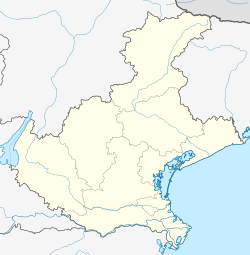Padua
Appearance
Padua
| |
|---|---|
| Città di Padova | |
 Prato della Valle | |
| Coordinates: 45°25′N 11°52′E / 45.417°N 11.867°E | |
| Country | Italy |
| Region | Veneto |
| Province | Padua (PD) |
| Frazioni | Altichiero, Arcella, Bassanello, Brusegana, Camin, Chiesanuova, Forcellini, Guizza, Mandria, Montà, Mortise, Paltana, Ponte di Brenta, Ponterotto, Pontevigodarzere, Sacra Famiglia, Salboro, Stanga, Terranegra, Volta Brusegana |
| Government | |
| • Mayor | Sergio Giordani (PD) |
| Area | |
| • Total | 92.85 km2 (35.85 sq mi) |
| Elevation | 12 m (39 ft) |
| Population (31 October 2011)[2] | |
| • Total | 214,125 |
| • Density | 2,300/km2 (6,000/sq mi) |
| Demonym(s) | Padovano Patavino |
| Time zone | UTC+1 (CET) |
| • Summer (DST) | UTC+2 (CEST) |
| Postal code | 35100 |
| Dialing code | 049 |
| Patron saint | Saint Anthony of Padua |
| Saint day | June 13 |
| Website | www |


Padua (Italian: Padova) is an Italian city near Venice. It has about 210,000 people.
An old myth says that Padua was founded by the Trojan Antenore. There was a settlement since the 4th century before Christ. It got under Roman power in 215 B.C. In 426 A.D. Padua became destroyed by Attila. Narses reconstructed the city, but the Langobardes destroyed it a second time. Charles, the Great got Padua in 774 under power of the Francs, later the city joined the Holy Roman Empire of German Nation.
After struggles with Frederic Barbarossa it declared peace in 1177. In 1222 the second university of Italy was founded in Padua. The Gulfs got Padua in 1256, later the Republic of Venice got control about the city until Napoleon Bonaparte got it.
References
[change | change source]- ↑ "Superficie di Comuni Province e Regioni italiane al 9 ottobre 2011". Italian National Institute of Statistics. Retrieved 16 March 2019.
- ↑ "Popolazione Residente al 1° Gennaio 2018". Italian National Institute of Statistics. Retrieved 16 March 2019.





